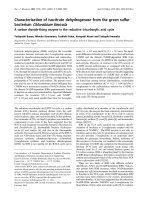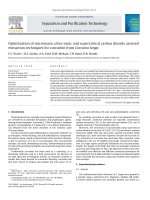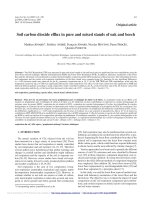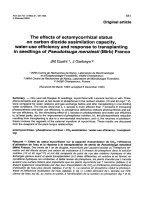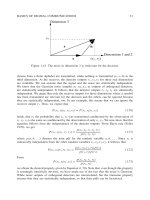Applications of electrospinning and supercritical carbon dioxide foaming techniques in controlled release and bone regeneration 8
Bạn đang xem bản rút gọn của tài liệu. Xem và tải ngay bản đầy đủ của tài liệu tại đây (26.16 KB, 5 trang )
Chapter 9 179
CHAPTER 9
C
ONCLUSIONS AND RECOMMENDATIONS
This thesis presents a successful application of electrospinning and supercritical CO
2
foaming techniques in the fabrication of biocompatible and biodegradable controlled
release formulations for the delivery of BMP-2 protein and BMP-2 plasmid. Fabrication
methods and detailed characterization of the BMP-2 protein-loaded and BMP-2 plasmid-
loaded formulations have been reported in this thesis.
Three-dimensional fibrous scaffolds fabricated by electrospinning contain microscale-
interconnected pores, resembling the extracellular matrix (ECM) and the three-
dimensional nature of the scaffolds allows for the infiltration and proliferation of cells.
Due to the limit of fibrous scaffolds in mechnical strength, they are not capable of being a
graft directly. As a result, the osteoconductive role of fibrous scaffolds in bone
regeneration is not investigated. However, BMP-2 protein loaded in fibrous scaffolds
performs well in the osteoinduction, and therefore enhances the bone healing in tibia
bone defect model (see Chapters 4 and 6, and Appendix A1). The incorporation of HAp
nanoparticles in fibrous scaffolds significantly enhanced the mechanical strength of
scaffolds. Moreover, the HAp nanoparticles incorporated in scaffolds were acting as a
regulator of BMP-2 release rate. Specifically, higher content of HAp can speed up the
Chapter 9 180
disintegration of the scaffolds, and subsequently enhance the release of BMP-2 protein
from scaffolds, as shown in the in vitro release profiles (Figures 3.6 and 5.5). Animal
experiments demonstrated that the bioactivity of BMP-2 protein released from
PLGA/HAp scaffolds was maintained and in vivo and satisfactory performance of bone
healing was observed.
For the case of BMP-2 plasmid delivery, the optimization of dosage forms on
cytotoxicity and transfection efficiency is crucial. Naked DNA has low transfection
efficiency so DNA loaded chitosan particles are used in DNA delivery due to their high
transfection efficiency, but the strong immunological reaction of cells posed by them is
undesirable. In order to preserve the advantage of polymeric particles and reduce
immunological effect at the same time, a new DNA release system is developed which
makes possible sustained DNA release and efficient transfection with negligible
immunological effects. BMP-2 plasmid was successfully encapsulated into polymeric
fibrous matrices in three different ways, and the animal experimental results indicate that
the bioactivity of BMP-2 plasmid released from all the three kinds of scaffolds was well
maintained, which helped improve the formation of new bone and the healing of segmental
defects in vivo. Groups A, B and C released DNA or DNA nanoparticles in different ways
and time frames (Chapter 5), thus their performances in bone healing were diverse (Chapter
6). Nevertheless, all three kinds of scaffolds meet the requirements set for “good” DNA
delivery devices, including low cytotoxicity and high transfection efficiency. The
conceptual advantages of group C scaffolds (see Chapters 5 and 6), which release plasmid
for longer than eight weeks, were not well demonstrated in the tibia bone defect model (see
Chapter 9 181
Appendix A1) as the bone defect will heal by itself in six-week period. To explore this, a
larger critical-sized defect will be required in the future study. Preliminary results on
critical-sized femur bone defect model suggest that all the three kinds of fibrous scaffolds
developed in this research (groups A, B and C) are promising for healing of critical-sized
bone defect (refer to Appendix A2).
For the three-dimensional PLGA foams produced via supercritical carbon dioxide, their
most attractive advantage is the formation of stable and porous structures
,
but the surfaces
will be negatively charged. In the latter part of this thesis (Chapters 7 and 8), two ways of
modifications are employed to investigate the effects of -NH
2
incorporation on cell
adherence, cell viability and in vitro expression. The results suggest that PLGA/chitosan
composites fabricated by the combination of spray drying and supercritical CO
2
foaming
techniques are promising for gene delivery. The chitosan incorporated was coated on the
surface of PLGA matrix in an amorphous form, which could help to slow down the
disintegration of PLGA matrix, consequently retarding the release of DNA from the
polymer matrix. The resultant sustained release of DNA led to low cytotoxicity and
sustained expression of gene. Moreover, cell attachment and cell viability are enhanced
with the aid of chitosan coating on the PLGA matrix.
PLGA porous foams can also be post-functionalized by Lysine-based peptides. The
adsorption capacity and release behavior of DNA were found to be highly dependent on
the charge properties of the foam surfaces. Because of the presence of ionic interaction
between the carboxyl groups of DNA and the amine groups added to the foams F1 and F2,
Chapter 9 182
the release rates of DNA from the K4- and K20-functionalized foams are more sustained
in comparison to the blank foam. The positively charged surface of the functionalized
foams appeared to be favorable for loading DNA and displayed sustained release of DNA,
possibly due to a balance of electrostatic interaction and hydrophilic interaction between
DNA and the surface of Lysine pepetide modified foams. The sustained release of DNA
from PLGA/chitosan and PLGA/Lysine foams led to negligible cytotoxicity and
sustained expression of DNA, which is favorable for DNA delivery and tissue
engineering applications.
In conclusion, this research has shown potential applications of electrospinning and
supercritical CO
2
foaming techniques in the fabrication of three dimensional scaffolds for
controlled release and bone regeneration. These two techniques can be easily extended to
the fabrication of other biomedical devices, such as drug delivery systems for treatment
of osteoporosis, brain tumor, central nervous system (CNS) and so on. However, several
specific disadvantages are still observed, and therefore call for further works for
improvement. Particularly, fibrous scaffolds used for BMP-2 protein delivery (Chapters 3
and 5) and BMP-2 plasmid delivery (Chapters 4 and 6) are not strong enough in
mechanical strength, limiting their use as bone graft. As a result, this function was served
by the dead bone segment and intra-medullary wire in the current animal model (see
Appendix A1) and scaffolds were just utilized to serve as a source of protein or DNA. In
future studies, the improvement of PLGA fibrous scaffolds on mechanical properties is
necessary. For the cases of PLGA/chitosan and PLGA/Lysine composites, their release
profiles have not been optimized so far. The release of DNA from PLGA/chitosan
Chapter 9 183
scaffolds is low, consequently it fails to produce high enough DNA concentration and
subsequent significant expression in site. In contrast, the release of DNA from
PLGA/Lysine scaffolds is fast but not sustainable, which is not favorable for tissue
engineering. Moreover, the DNA from both PLGA/chitosan and PLGA/Lysine
composites is in form of naked DNA and its transfection efficiency is extremely low,
which would hinder their applications in biomedical engineering. In future investigations,
DNA/polycationic complexes, such as DNA/chitosan, DNA/PEI and DNA/PLL, can be
incorporated into or onto the foams in some way, on the conditions that the release of
DNA/polycationic complex from the foams is significant and sustainable. Thus a
comprehensive animal investigation on the PLGA/chitosan scaffolds and PLGA/Lysine
scaffolds is deserved.
As a versatile technique, electrospinning can be used for the fabrication of core/shell
structured microfibers and microspheres (for the case of electrohydrodynamic
atomization or EHDA) for co-release or even sequential release of multi-drugs (chemical
drugs, proteins, DNA or combinations of them) in the future. Bone regeneration is a
complicated process involving many growth factors and different growth factors have
diverse roles in different stages of bone regeneration, therefore a sequential release of
growth factors from a single release device is highly demanded. This will result in a more
effective treatment for bone defects as compared to the treatment by a singale growth
factor offered by existing delivery systems.

